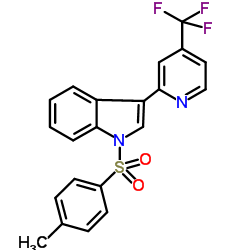SUCROSE PHOSPHORYLASE

SUCROSE PHOSPHORYLASE structure
|
Common Name | SUCROSE PHOSPHORYLASE | ||
|---|---|---|---|---|
| CAS Number | 9074-06-0 | Molecular Weight | 416.416 | |
| Density | 1.4±0.1 g/cm3 | Boiling Point | 584.0±60.0 °C at 760 mmHg | |
| Molecular Formula | C21H15F3N2O2S | Melting Point | N/A | |
| MSDS | USA | Flash Point | 307.0±32.9 °C | |
Use of SUCROSE PHOSPHORYLASESucrose phosphorylase is a bacterial transglucosidase that catalyzes the conversion of sucrose and phosphate into α-D-glucose-1-phosphate and D-fructose. The glucosylated Sucrose phosphorylase can also be hydrolyzed into α-D-glucose, or transfer the glucoyl to the hydroxyl group of the receptor, and then decomposed into new α-D-glucoside products. The enzymatic activity of base phosphorylase to substrate and product is weak[1]. |
| Name | 1-[(4-Methylphenyl)sulfonyl]-3-[4-(trifluoromethyl)-2-pyridinyl]-1H-indole |
|---|---|
| Synonym | More Synonyms |
| Description | Sucrose phosphorylase is a bacterial transglucosidase that catalyzes the conversion of sucrose and phosphate into α-D-glucose-1-phosphate and D-fructose. The glucosylated Sucrose phosphorylase can also be hydrolyzed into α-D-glucose, or transfer the glucoyl to the hydroxyl group of the receptor, and then decomposed into new α-D-glucoside products. The enzymatic activity of base phosphorylase to substrate and product is weak[1]. |
|---|---|
| Related Catalog | |
| References |
| Density | 1.4±0.1 g/cm3 |
|---|---|
| Boiling Point | 584.0±60.0 °C at 760 mmHg |
| Molecular Formula | C21H15F3N2O2S |
| Molecular Weight | 416.416 |
| Flash Point | 307.0±32.9 °C |
| Exact Mass | 416.080627 |
| LogP | 5.56 |
| Vapour Pressure | 0.0±1.6 mmHg at 25°C |
| Index of Refraction | 1.610 |
| Storage condition | 20°C |
| RIDADR | NONH for all modes of transport |
|---|
|
Positively charged mini-protein Zbasic2 as a highly efficient silica binding module: opportunities for enzyme immobilization on unmodified silica supports.
Langmuir 28(26) , 10040-9, (2012) Silica is a highly attractive support material for protein immobilization in a wide range of biotechnological and biomedical-analytical applications. Without suitable derivatization, however, the sili... |
|
|
Phosphorolytic cleavage of sucrose by sucrose-grown ruminal bacterium Pseudobutyrivibrio ruminis strain k3.
Folia Microbiol. (Praha) 55(4) , 383-5, (2010) Rumen bacterium Pseudobutyrivibrio ruminis strain k3 utilized over 90% sucrose added to the growth medium as a sole carbon source. Zymographic studies of the bacterial cell extract revealed the presen... |
|
|
Enzymatic synthesis of stable, odorless, and powdered furanone glucosides by sucrose phosphorylase.
Biosci. Biotechnol. Biochem. 64 , 134, (2000) Sucrose phosphorylase from Leuconostoc mesenteroides catalyzed transglucosylation from sucrose to 4-hydroxy-3(2H)-furanone derivatives. When 4-hydroxy-2,5-dimethyl-3(2H)-furanone (HDMF) and 2-ethyl-4-... |
| 1-[(4-methylphenyl)sulfonyl]-3-[4-(trifluoromethyl)pyridin-2-yl]-1H-indole |
| 1-[(4-Methylphenyl)sulfonyl]-3-[4-(trifluoromethyl)-2-pyridinyl]-1H-indole |
| 1H-Indole, 1-[(4-methylphenyl)sulfonyl]-3-[4-(trifluoromethyl)-2-pyridinyl]- |
| MFCD00132397 |

